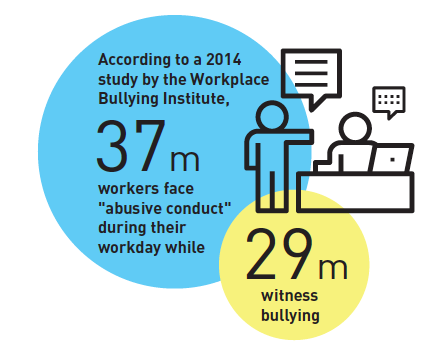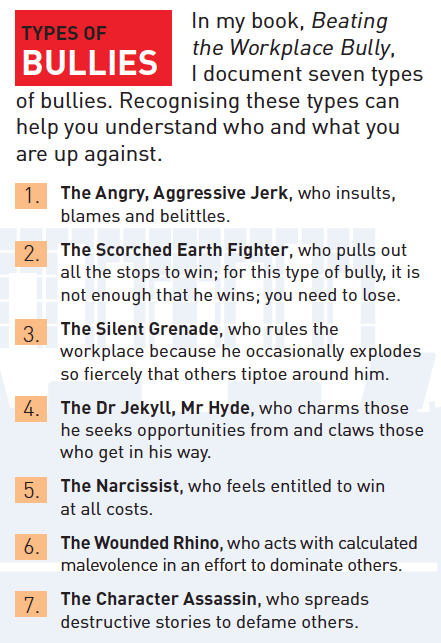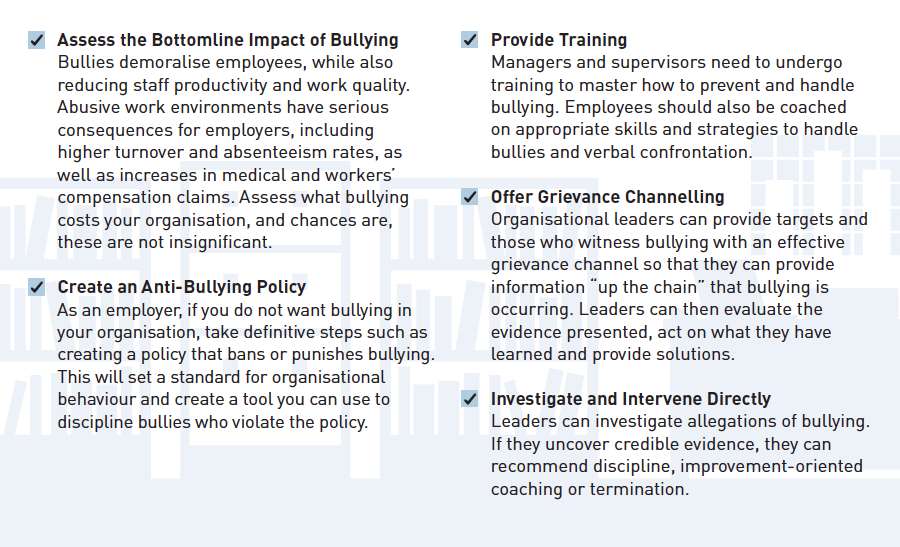By Lynne Curry
We've all met at least one in the course of our careers. He, or she, is the angry, aggressive bully who insults you to your face and behind your back. You would expect that at some point they would tire of this behaviour, but bullies thrive on demeaning and belittling you. Meanwhile, being bullied saps your emotional and physical energy until you finally resign from a job you once loved.
Bullying: A Global Epidemic
Workplace or corporate bullying is certainly real in Singapore, as shown in news reports over recent years,1 but it is an issue not faced by Singaporeans alone. In Australia, a 2016 survey found that as many as half of all Australian employees experience or have experienced bullying during their careers.2 The country, which passed Brodie’s Law3 in 2011, has made bullying—occurring anywhere, whether in the workplace, on social networking sites, or in schools—a serious criminal offence punishable by up to ten years in jail. And in the United States, a 2014 study by the Workplace Bullying Institute revealed that over 37 million workers face “abusive conduct” during their workday and almost 29 million others witness bullying.4 This figure of about 66 million equates to three to four out of every ten workers experiencing bullying.

So what exactly is bullying? What happens in organisations that allow bullying? Why do employers allow it? How can organisations fix this? And what if you only witness bullying?
More Than Just Someone Having a Bad Day
We all know rude individuals or those who occasionally lash out at others in stressful situations. Bullies, however, repeatedly and intentionally humiliate or intimidate their targets. To readily identify a bully in action, there must be a consistent pattern of psychological violence and aggressive manipulation against his or her victim(s).
What Disappears in a Culture of Workplace Bullying?
The organisations that allow bullying to happen suffer, as do those who work in them. On the individual level, employees who experience or witness bullying lose self-esteem and job satisfaction, while on the company level, the entire organisation will suffer a decline in productivity, staff engagement, work quality, employee loyalty and reputation.
When Bullying Runs Rampant
Companies that ignore or enable bullying to go on will typically see an increase in employee absenteeism, grievances, turnover, and in more extreme cases, workers’ compensation claims and litigation. Moreover, victims develop feelings of anxiety, depression and angst as a result of their bullying, and these negative psychological impacts can cause a significant dip in their performance at work.

Understanding What Creates the Bully Exception
With all these negative consequences, one might wonder why some organisations would turn a blind eye to bullying in the first place. This is because in many cases, even though their behaviour damages staff morale and productivity, many workplace bullies are high-achieving individuals who produce good results for the company. This thus leads senior management to perceive them not as bullies, but hard-charging, task-driven characters.
It is not surprising, therefore, that when fellow employees speak out against their bullying actions, these protests fall on deaf ears, or are met with responses like, “Say what you will about John, he achieves results.” Further, many bullies excel at workplace politics, and as the phrase goes, are able to “kiss up even as they kick sideways and down”. This can explain why senior management may seem “blind” to the bully’s destructive behaviours, refuting bullying claims with responses like, “But that’s not the John I know.”
What You Need to Know
Whether you face a bully or suspect one of your employees may be one, there are some things to keep in mind.
- You can’t expect a bully to go away on his or her own. Because most bullies are high performers at work, they are valued by the organisation, and believe others will give them what they want if they intimidate or create fear in their targets.
- You can’t ignore a bully. Bullies test their potential victims, but that is a test you want to fail. If a bully is convinced that you are an easy target, he will intensify the frequency and scale of his attacks, and the problem can quickly spiral out of control.
- You can’t kill them with kindness. With bullies, niceness fails, because they perceive that as a weakness.
Call to Action
What can employers and human resources professionals do to address corporate bullying? The following is a handy checklist to start with. 
What If You Only Witness, But Are Not a Victim of Bullying?
If you witness bullying, please understand there is no witness protection. If you remain silent, you let the bully know that you sanction his or her actions, show the target that you do not care enough to act, and give the bully the sense that you fear him or her—potentially positioning yourself as a future target.
For more information, read my book, Beating the Workplace Bully (US$15.25 via Amazon). Published by AMACOM, it is a self-training guide for individuals facing corporate bullying and managers or organisations looking to eradicate bullying. I also created, together with my teammate Rick Birdsall, an employment-attorney-turned-HR-consultant, a website dedicated to wiping out bullying in our lifetime, bullywhisperer.com™.
Notes
1 APTN/AFP, “Video Shows Singapore Office Supervisor Assaulting Colleague”, The Telegraph, 22 May 2013, at http://www.telegraph. co.uk/news/worldnews/asia/singapore/10072829/Video-shows- Singapore-office-supervisor-assaulting-colleague.html; Nicholas Goh, “Facing Up to Bullies at the Workplace”, The Straits Times, 24 February 2014, at http://www.straitstimes.com/singapore/facingup- to-bullies-at-the-workplace; Maureen Koh, “Man Suffers Mental Breakdown after Constant Bullying At Workplace”, The New Paper, 3 May 2015, at http://www.tnp.sg/news/singapore/man-suffersmental- breakdown-after-constant-bullying-workplace
2 Robyn Powell, “Half of All Australians Experience Workplace Bullying, Survey Finds”, ABC News, 9 October 2016, at http://www.abc.net.au/news/2016-10-09/half-all-australiansexperience- workplace-bullying-survey-finds/7916230
3 Brodie’s Law is named after Brodie Panlock, a young woman who took her life after being subjected to relentless bullying at her workplace. State Government of Victoria, Department of Justice and Regulation, “Bullying— Brodie’s Law”, at http://www.justice.vic.gov.au/home/safer+communities/crime+prevention/bullying+- +brodies+law
4 Gary Namie, 2014 WBI U.S. Workplace Bullying Survey (San Francisco Bay Area, CA: Workplace Bullying Institute, 2014), at http://workplacebullying.org/multi/pdf/WBI-2014-US-Survey.pdf
 |
Lynne Curry, PhD, SPHR, is the author of Solutions and Beating the Workplace Bully, self-help titles on managing office issues and corporate bullies, respectively. Based in Anchorage, Alaska, she is the founder of the consulting, training, human resources and organisational strategy firm, The Growth Company, Inc., and is Regional Director of Training and Business Consulting for Avitus Group, a US-based co-employment organisation. Lynne is also the founder of two websites: workplacecoachblog.com, an online Q&A platform that provides advice and answers to career-related questions; and bullywhisperer.com™, an anti-bullying blog community that shares experiences, as well as tools, techniques and advice on how to tackle corporate bullying. Beating the Workplace Bully’s Mandarin edition will be published in 2018. Connect with Lynne via Twitter @lynnecurry10 or email her at LCurry@avitusgroup.com |








Comments